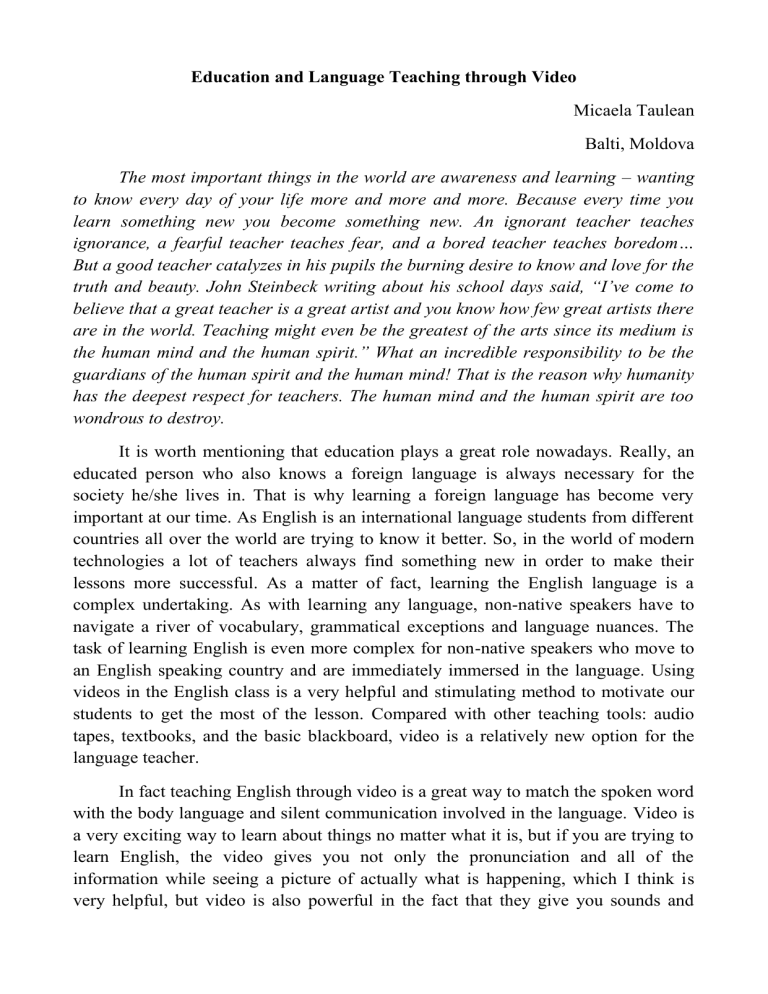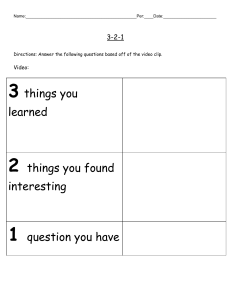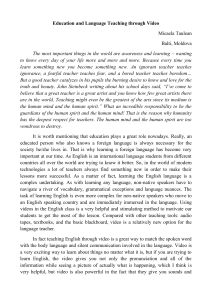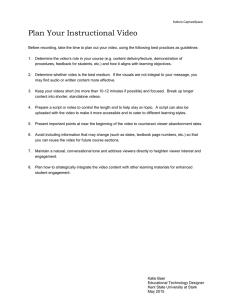
Education and Language Teaching through Video Micaela Taulean Balti, Moldova The most important things in the world are awareness and learning – wanting to know every day of your life more and more and more. Because every time you learn something new you become something new. An ignorant teacher teaches ignorance, a fearful teacher teaches fear, and a bored teacher teaches boredom… But a good teacher catalyzes in his pupils the burning desire to know and love for the truth and beauty. John Steinbeck writing about his school days said, “I’ve come to believe that a great teacher is a great artist and you know how few great artists there are in the world. Teaching might even be the greatest of the arts since its medium is the human mind and the human spirit.” What an incredible responsibility to be the guardians of the human spirit and the human mind! That is the reason why humanity has the deepest respect for teachers. The human mind and the human spirit are too wondrous to destroy. It is worth mentioning that education plays a great role nowadays. Really, an educated person who also knows a foreign language is always necessary for the society he/she lives in. That is why learning a foreign language has become very important at our time. As English is an international language students from different countries all over the world are trying to know it better. So, in the world of modern technologies a lot of teachers always find something new in order to make their lessons more successful. As a matter of fact, learning the English language is a complex undertaking. As with learning any language, non-native speakers have to navigate a river of vocabulary, grammatical exceptions and language nuances. The task of learning English is even more complex for non-native speakers who move to an English speaking country and are immediately immersed in the language. Using videos in the English class is a very helpful and stimulating method to motivate our students to get the most of the lesson. Compared with other teaching tools: audio tapes, textbooks, and the basic blackboard, video is a relatively new option for the language teacher. In fact teaching English through video is a great way to match the spoken word with the body language and silent communication involved in the language. Video is a very exciting way to learn about things no matter what it is, but if you are trying to learn English, the video gives you not only the pronunciation and all of the information while seeing a picture of actually what is happening, which I think is very helpful, but video is also powerful in the fact that they give you sounds and background and a lot of other unspoken parts of our English language, and that is very important [1]. Moreover, using videos is one of effective ways to introduce particular language points that needs to be practiced in classroom. A teacher can stress out on pronunciation. From my point of view using videos will facilitate better understanding and recognition of English sound, intonation, and stress pattern. A teacher can make students practice on using certain grammar rules, such as past tense, present continuous, and perfect. Videos are helpful in teaching listening and speaking activities. Students forget themselves in the content, indirectly acquiring language. Besides, video is very necessary in classrooms. It creates a very interesting atmosphere and students respond very well [2]. Without doubt, videos have a great number of advantages in teaching a language. First, the teacher can attract the students’ attention easily. Second, using videos is a good way to teach them some difficult points vividly. Finally, when they watch videos, they will enjoy themselves. Using multimedia resources in the classroom makes teaching-learning a lively process. Students are learning better with the help of such tools. Indeed, using video in the classroom breaks monotony and brings a positive change into the class. However, this is not always possible in schools because of the lack of video players and suitable discs. Presently videos are very stimulating and effective in triggering the imagination of the students. As they say “A picture is worth thousand words.” A teacher always needs to use some resources to keep the students’ interest. Video can be one of them. It faces the students to real situations. It is often excellent to make them speak, even if they are at the very beginning stage. Due to videos, teachers have found a very effective tool for proficiency development [3]. Nowadays using video has become popular and integral part of the teaching activity, even in the one-to-one system. The BBC programs offer a lot of good ideas, i.e. recording episodes of popular serials, or selected short programs. These recordings can be used for practicing in the 4 skills and students enjoy them very much. Watching video combined with well prepared “before watching” and “after watching” tasks - including vocabulary building and making a grammar review. It is much more attractive and exciting, than getting into touch with the “dry and boring” course matters. There are a lot of different methods to teach English with the help of videos. One task might be to turn off the sound and ask students to make up a dialogue from a scene they have just watched. Another one would be to simply let just a part of the class watch a video, then have them describe to the others what they have seen and understood. At the same time the teacher can freeze certain moments of the video, by watching and pausing at very exciting moments, then ask students to predict what may happen next. [4] For the first viewing, the teacher tells the students that their main aim is to identify the general topic of each item. When the teacher shows the video again he/she asks students to make more detailed notes on each item. In order to better facilitate this, he/she should pause the video after each item. Students can check the information they noted down with their partner or group. After watching a film, students get the chance to practice their presentation skills by being film critics. The teacher can also challenge learners to practice their parts of speech skills by picking out words of different types from the videos watched. As students advance in their English-learning skills, the teacher may use videos as a vehicle to practice parts of speech. Likewise the teacher can instruct students to write down all the nouns, verbs, adjectives or adverbs that they hear in a section of video. [5] We consider rather useful Randall Rightmire’s1 ideas of video-clips in ESL classes (his article “Using Video in the ESL Class”). Janet Goodwin pioneered this method at UCLA for use with advanced students. It can be adapted for students of all levels. A)Teaching Pronunciation with Video Clips I. Choosing a clip 1. Choose a clip that is short (2-4 minutes) 2. Lots of visual context, including non-verbal communication 3. Recognizable, everyday situations 4. Humor, humor, humor 5. Informal, conversational language; lots of back-and-forth turn-taking 6. The clip should represent a wide variety of rhythm and intonation patterns II. Using the clips in the classroom Step 1: Before the exercise: 1 Let the students know that the purpose of the exercise will be to practice the pronunciation of a variety of English intonation & rhythm patterns. Randall Rightmire, Using Video in the ESL Class, Linguistics 139/239 presentation, February 20, 2007 Explain that the procedure will be to (a) listen to the characters and (b) try to imitate their pronunciation. Step 2 (Optional): Any minimal introductory comments (such as “Has anyone ever seen Forrest Gump?” or “Who has heard of Tom Hanks?”) Step 3: Play the clip once, with the sound off, and with captions/subtitles off. Repeat if desired. Step 4: Ask the students, “Who are they? What is their relationship? What is the setting? What is their situation? How do they feel?” Step 5 (Optional): Ask students to read silently through the script. They may ask any questions about unfamiliar vocabulary. Step 6: Play the clip again, with the sound on, and the captions or subtitles on. They can read along in the script if they choose. (This is an especially good idea if you have skipped the optional Step 4.) Repeat if desired. Step 7: Read the script aloud, call-response style, line by line, sentence by sentence, or phrase by phrase. Step 8: Elect students to play the parts on their own, with minimal teacher guidance. III. Two or three students can perform it for the whole class. Students can pair up or group us to read the script. Students can read it as a read-around, with every student taking a line. For a good laugh, divide the room into two halves, each half reading one part in chorus! Examples—Video Clips for Pronunciation Mona Lisa Smile2 Betty: Watson: Joan: Watson: 2 What is that. You tell me. Carcass. By Soutine. 1925. It’s not on the syllabus. No. It’s not. Written by Lawrence Konner & Mark Rosenthal,Directed by Mike Newell Source: http://www.imdb.com/title/tt0304415/ Is it any good? Hm? Come on, ladies. There’s no wrong answer. There’s also no textbook telling you what to think. It’s not that easy, is it. Betty: All right, no. it’s not good. In fact, I wouldn’t even call it art. It’s grotesque. Connie: Is there a rule against art being grotesque? Giselle: I think there’s something aggressive about it. And erotic. Betty: To you, everything is erotic. Giselle: Everything is erotic. Watson: Girls. Joan: Aren’t there standards? Betty: Of course there are. Otherwise, a tacky velvet painting, could be equated to a Rembrandt. Connie: Hey, my uncle Ferdie has two tacky velvet paintings; he loves those clowns. Betty: There are standards! Technique! Composition, color, even subject. So, if you’re suggesting that rotted side of meat is art, Much less good art, Then what are we going to learn? Watson: Just that. You have outlined our new syllabus, Betty. Thank you. What is art? What makes it good or bad? And who decides? Next slide please? Twenty-five years ago, someone thought this was brilliant. Connie: I can see that. Betty: Who. Watson: My mother. I painted it for her birthday. Next slide? This is my mom. Is it art? Joan: It’s a snapshot. Watson: If I told you Ansel Adams had taken it, would that make a difference? Betty: Art isn’t art until someone says it is. Watson: It’s art! Betty: The right people. Watson: Who are they. Connie: Betty Warren. We’re so lucky we have one of them right here. Betty: Screw you! Watson: Could you go back to the Soutine, please? Just .. look at it again. Look beyond the paint. Let us try to open our minds to .. a new idea. Hm? All right. Back to ..Chapter Three. Has anyone read it? B)Multi-Skills Lesson for Advanced ESL This is an activity for high-intermediate to advanced students. It assumes students can read quickly enough to follow along in a script, while the movie clip is playing, as quickly as the actors read their lines. I. Choosing a clip 1. 2. 3. 4. 5. II. Choose a story-within-the-story—a segment with a clear beginning and end. Clips of 10-25 minutes fit well into a 90-minute or two-hour class format. Is the situation easy to identify? What background will you have to provide? Is there a topic / theme (family, work, school, politics, society, environment)? Is the vocabulary accessible? Is the pronunciation clear? Is the clip free of ambient noise? Preparing materials 1. Decide how much prep you want to do. Will it be a simple fill-in? Will you add reinforcing vocabulary exercises for before/after the listening? Will you add follow-up discussion topics? Writing topics? 2. Download a script if possible, so that you won’t have to type it yourself. 3. Even if you download a script, check it once with the video on; errors happen! 4. Download movie facts for pre-listening (optional). Actor bios, photos, director filmographies, and plot synopses can make the lesson come alive. 5. Do you need to footnote any slang, idioms, or unusual vocabulary? 6. Choose a sampling of words to blank out. 7. Print a copy of the whole script as your answer key. III. Using the clip in class 1. Turn off the close-captioning. 2. If the clip is short (10 minutes or less), you might show it twice. Ask students not to look at their script the first time. How much of the gist can they get without help from the script? These are only a few suggestions about the use of videos during class. Those who have used videos are of the opinion that students greatly enjoy such a method, because it motivates them to try to express themselves in a different language from their mother tongue, get a perspective on the cultural aspects of the English speaking world, and so on. [6] To sum it up it is worth noting that using video in the classroom can be both an interesting approach to a subject and a warm up to develop different themes. Also it is a reliable way to learn the language in a real context, listening to native speakers. The main functions of using videos during the English classes are that of motivating and helping students to understand this language. References: 1. Stempleski, S., & Tomalin, B. (1990). Video in action. New York: Prentice Hall. 2. Finocchiaro, M. (1989). English as a second foreign language: Making effective use of video. New Jersey: Prentice Hall Regents. 3. www.teachingenglish.org.uk/think/articles/video-young-learners-1 4. www.teachingenglish.org.uk/think/articles/video-young-learners-2 5. www.ehow.com/video_5103554_teach-english-throughfilms.html#ixzz1pcBYmCtk 6. www.Grammarly.com/Grammar_Checker Useful web-links: ESL Magazine article “New Ways of Using Video Technologies in English Language Teaching” by Naomi Migliacci http://www.eslmag.com/modules.php?name=News&file=article&sid=25 ERIC’s article “Practical Aspects of Using Video in the EFL and ESL Classroom” by Christine Canning-Wilson www.eric.ed.gov/sitemap/html_0900000b801268e2.html Lectures from UCTV on Google Video http://video.google.com/videosearch?q=uctv Examples: Beyond The Human Genome: What's Next? Executive Power and the War on Terror The Media's Financial Influence on Politics Music and the Mind The Republican War on Science


